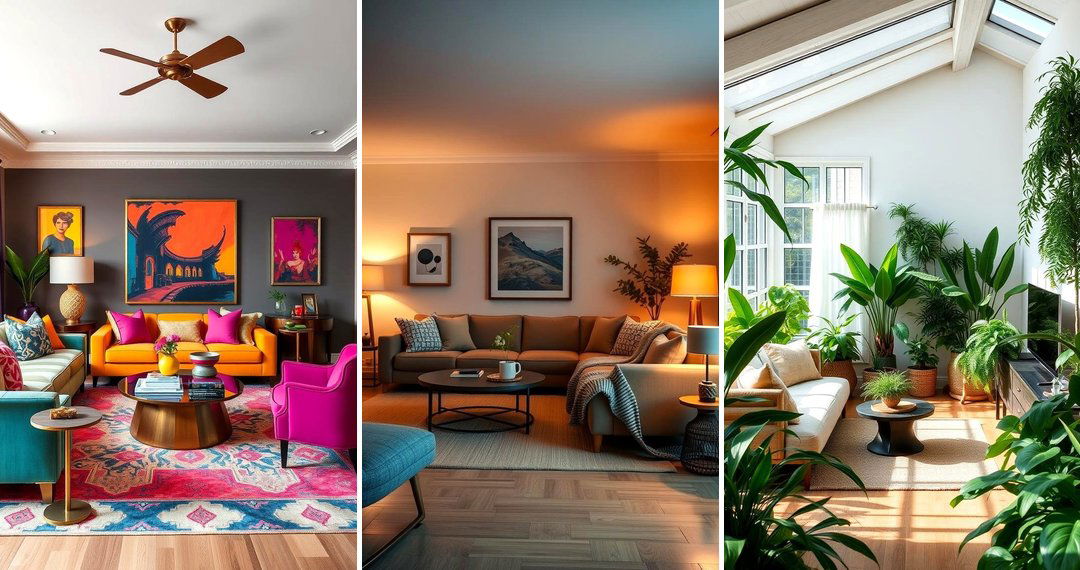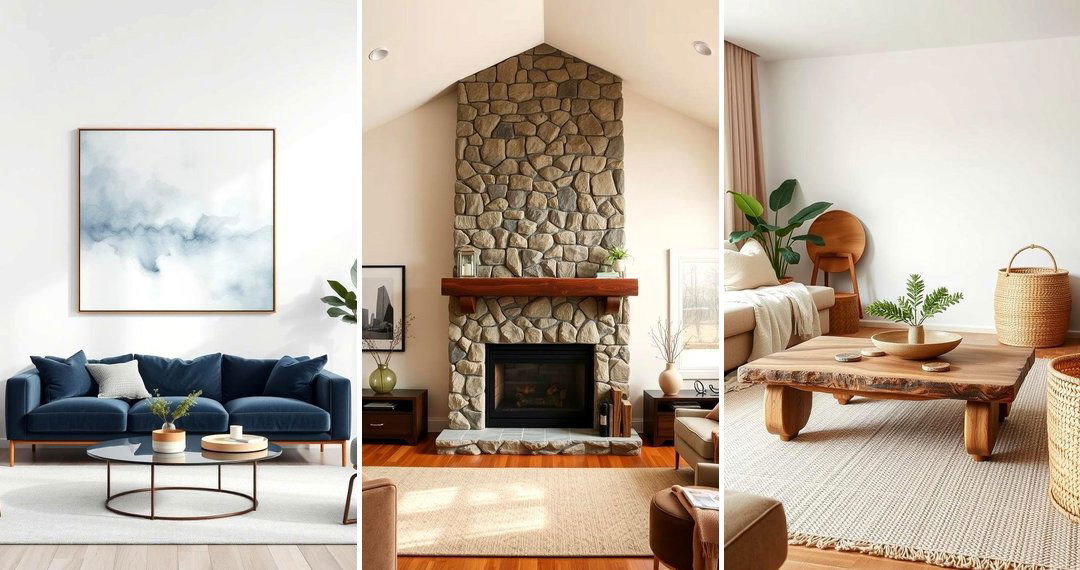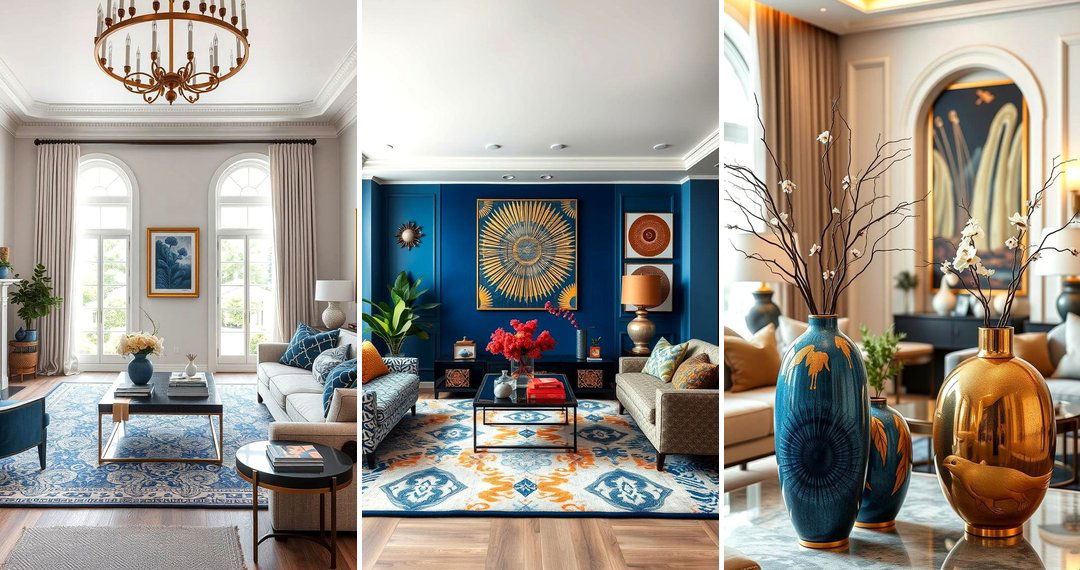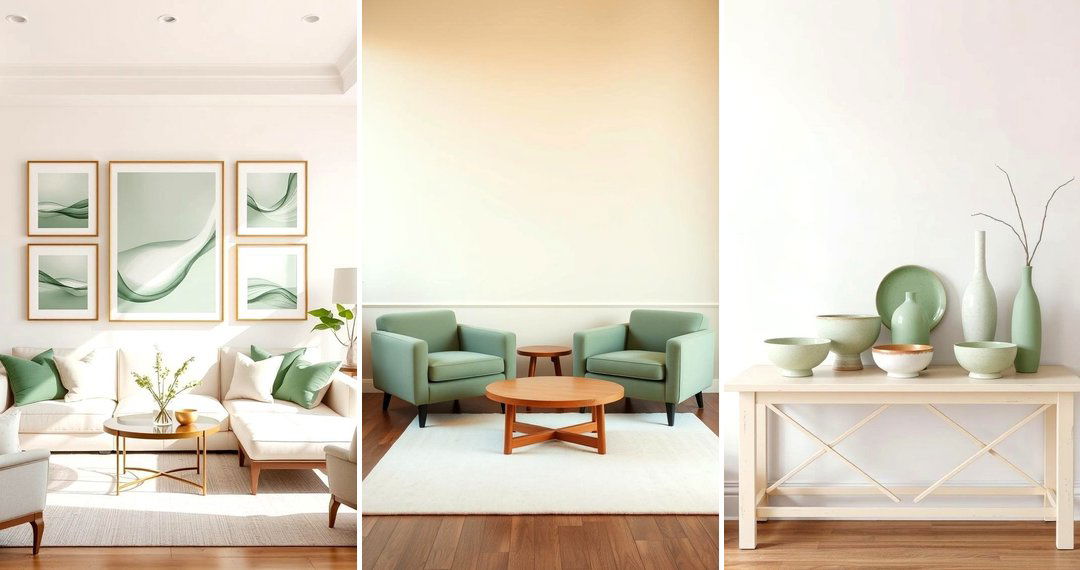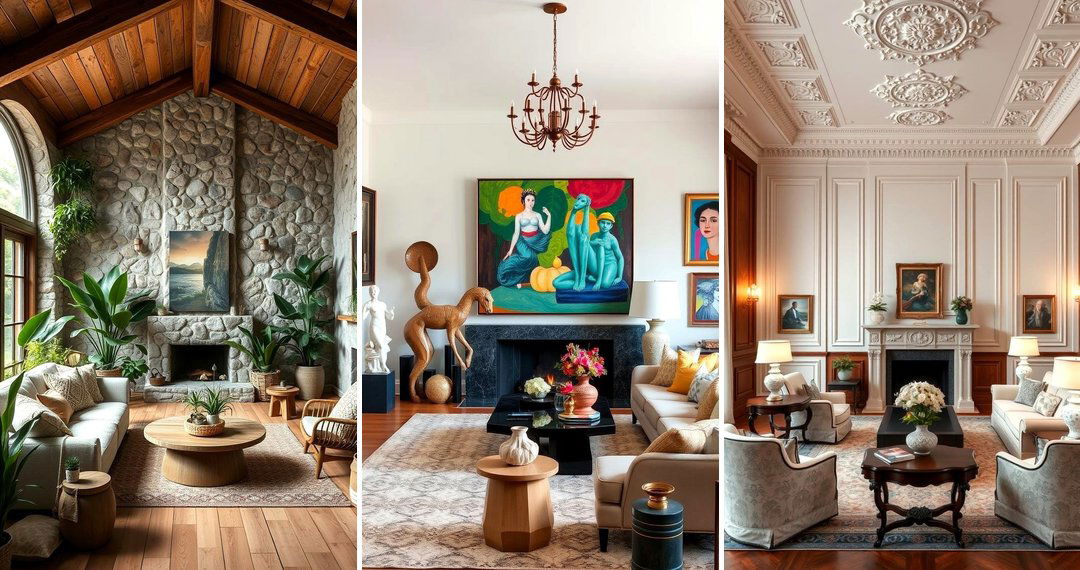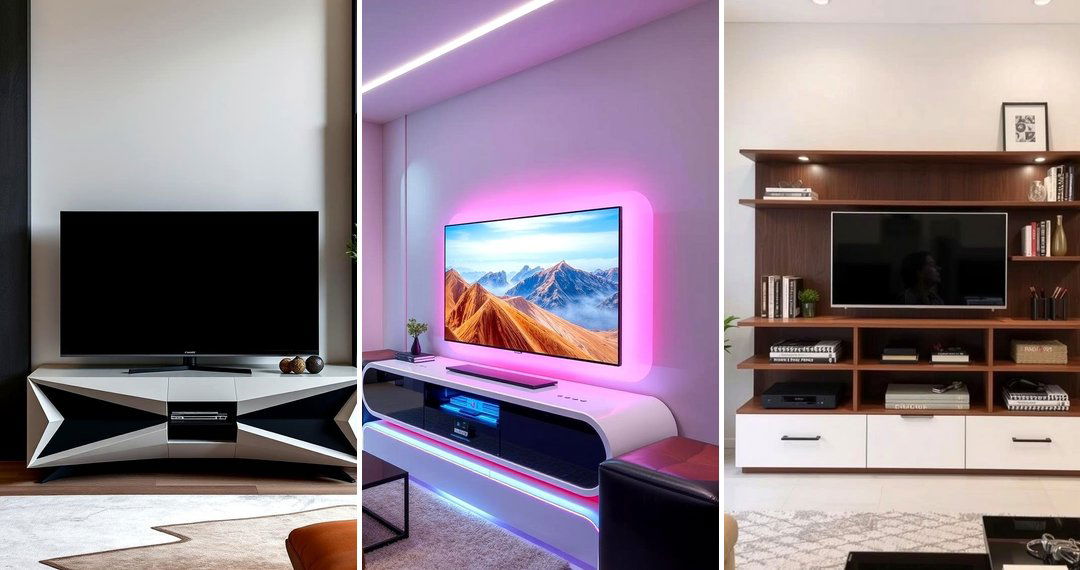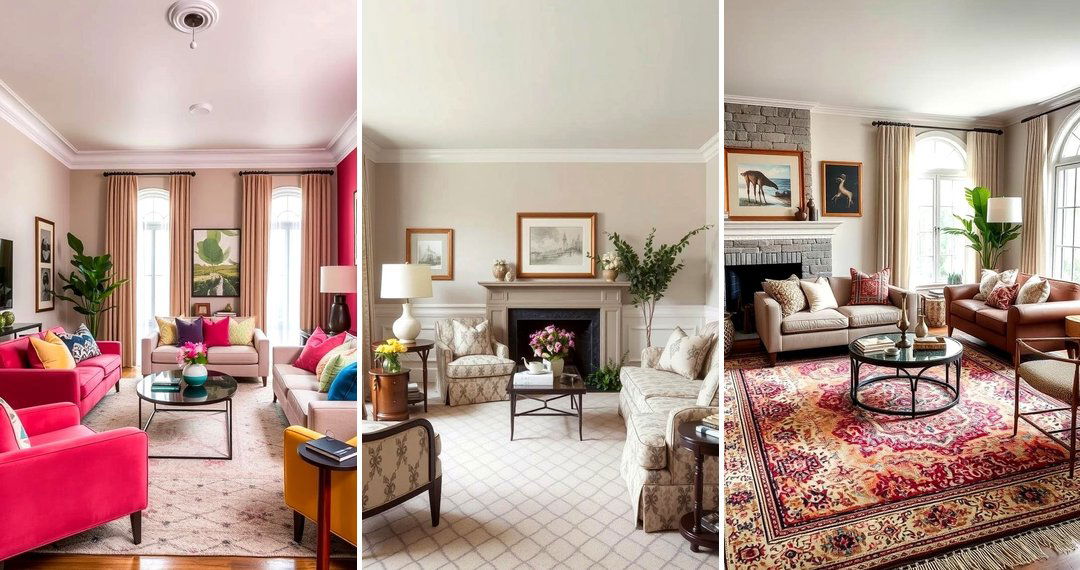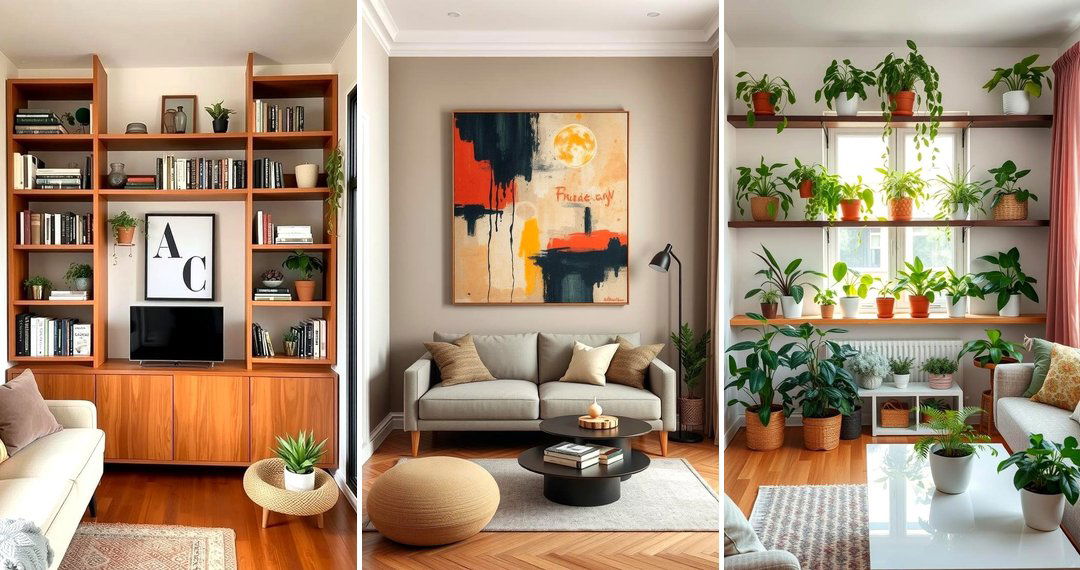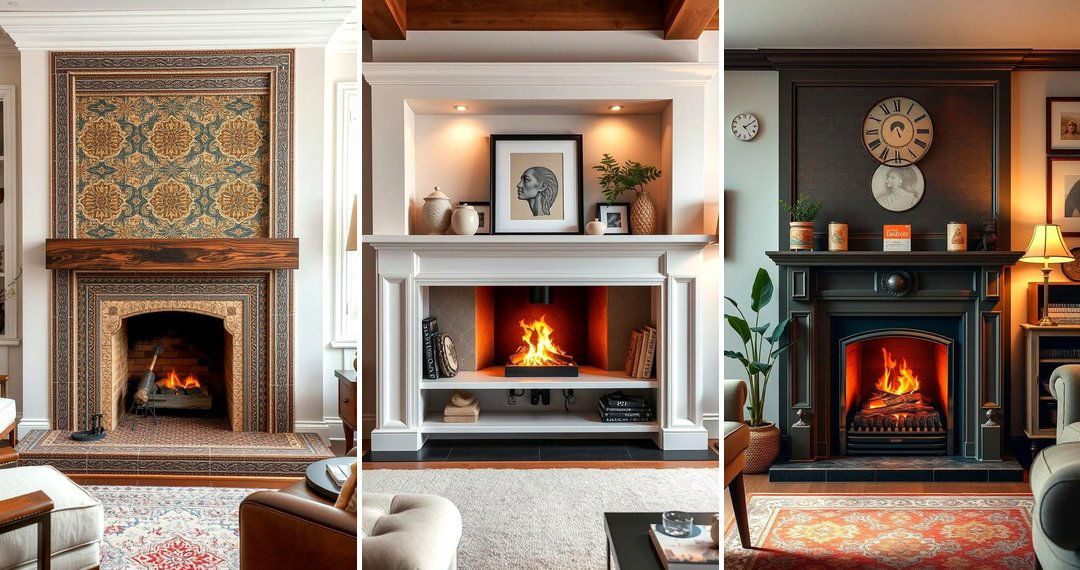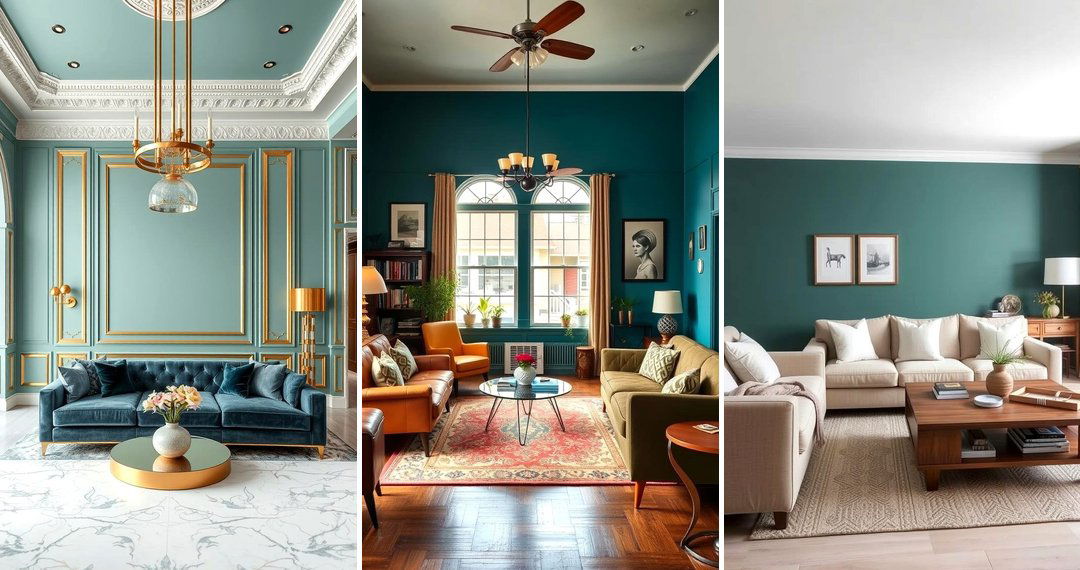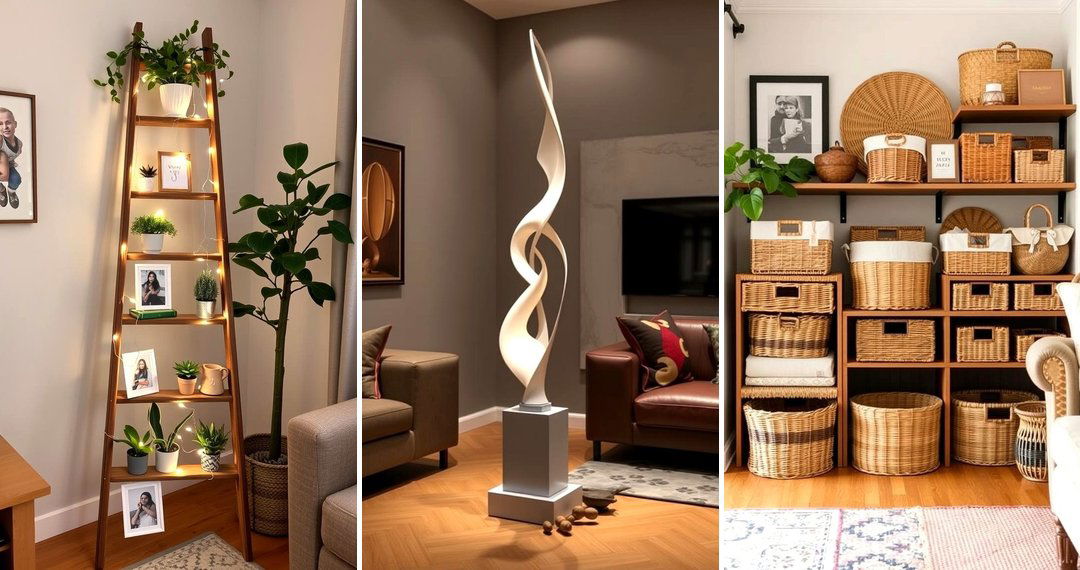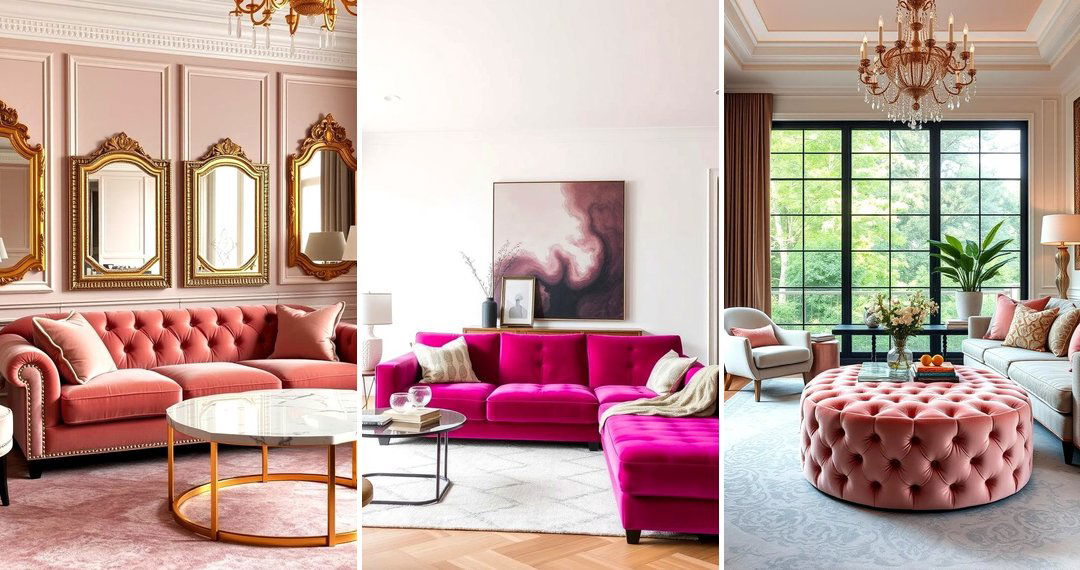Embracing tranquility and understated elegance, Japanese style living rooms offer a sanctuary of calm amidst the hustle and bustle of modern life. These spaces, steeped in tradition, prioritize natural materials, clean lines, and a harmonious connection with nature. Rooted in principles of minimalism and functionality, Japanese living room ideas invite a sense of peace and mindfulness. The beauty lies in the simplicity, where carefully chosen elements create an atmosphere of serenity. Discover how to transform your living space into a haven of Japanese-inspired tranquility by exploring the following ideas.
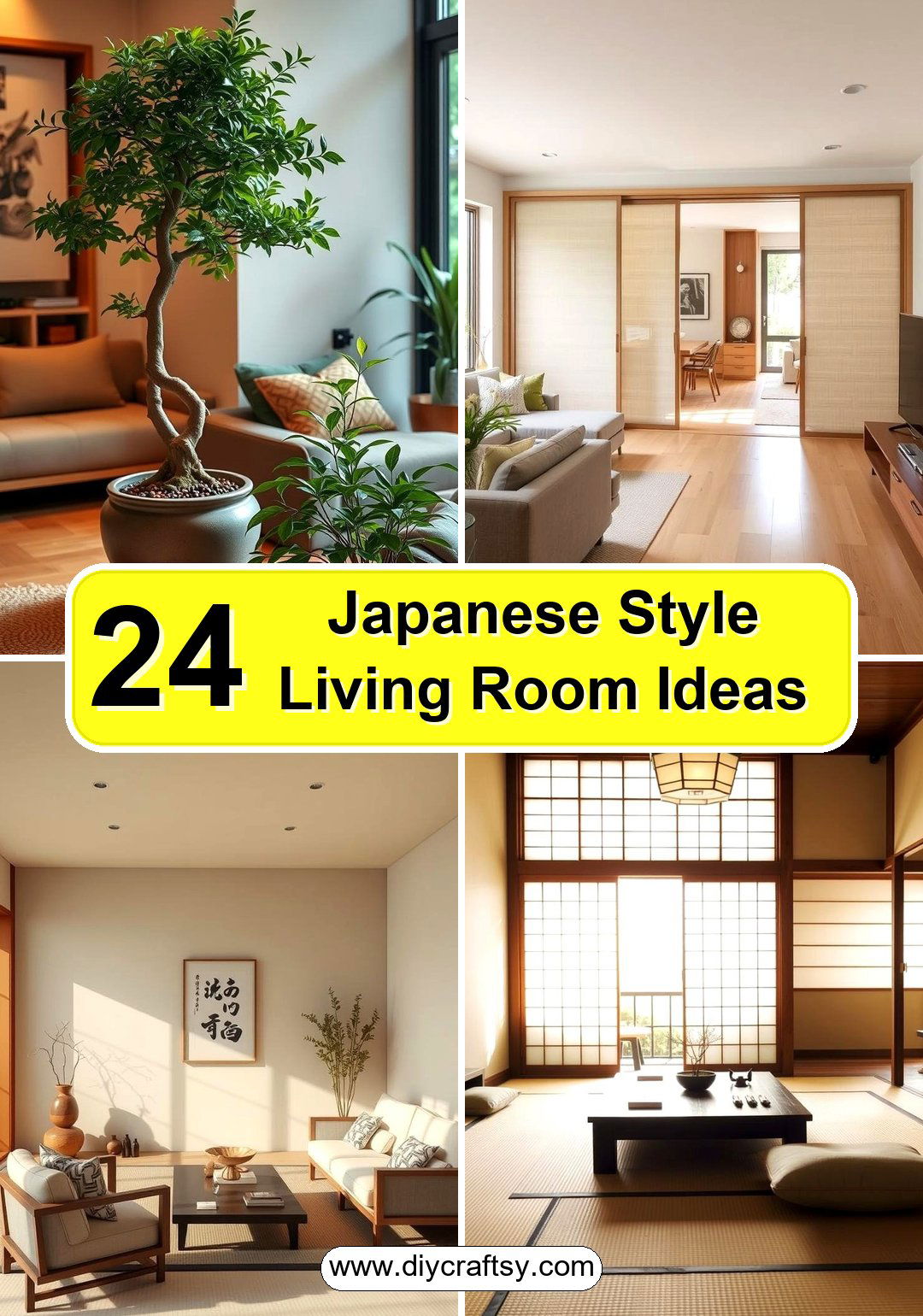
1. Tatami Mat Sanctuary
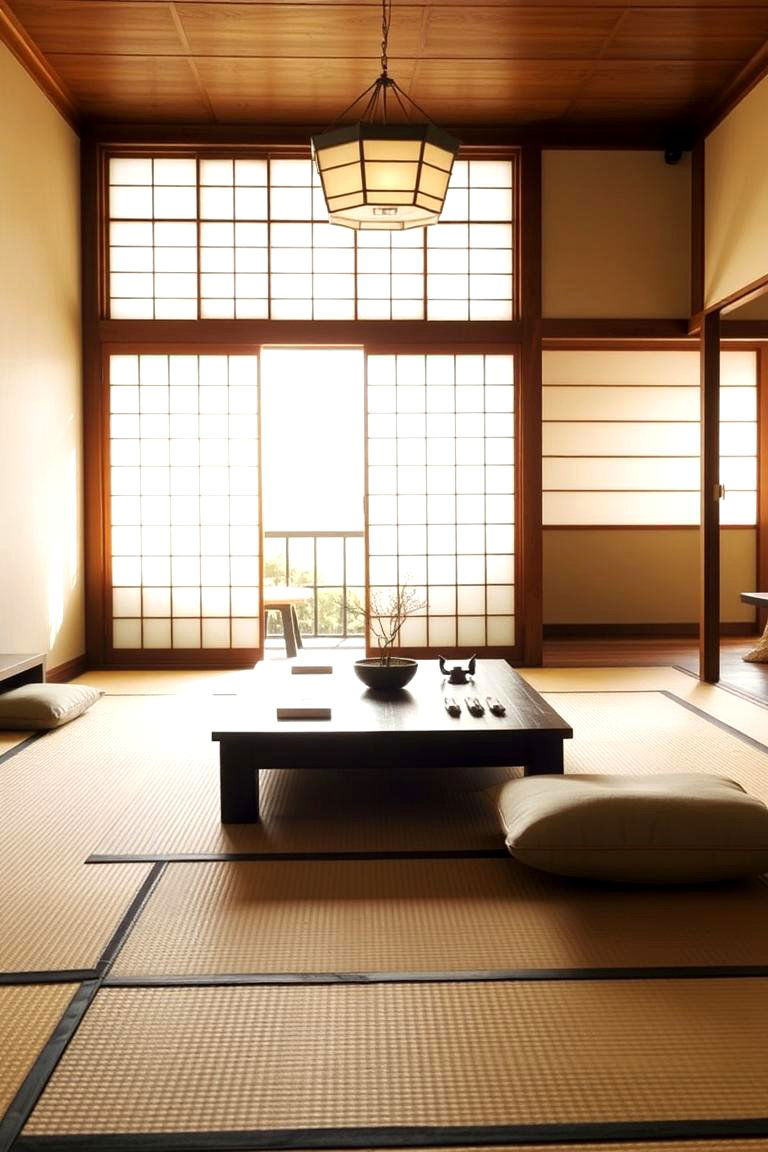
Imagine stepping onto the soft, natural texture of tatami mats, instantly grounding the space and inviting relaxation. These woven rice straw mats are a cornerstone of Japanese interiors, offering a unique aroma and a comfortable surface underfoot. Beyond their sensory appeal, tatami mats provide practical benefits like natural insulation and sound dampening. Consider incorporating them as a full flooring solution or as designated areas to define the living space within a larger room. The modular nature of tatami allows for flexible layouts, adapting to your specific needs and preferences.
2. Shoji Screen Serenity
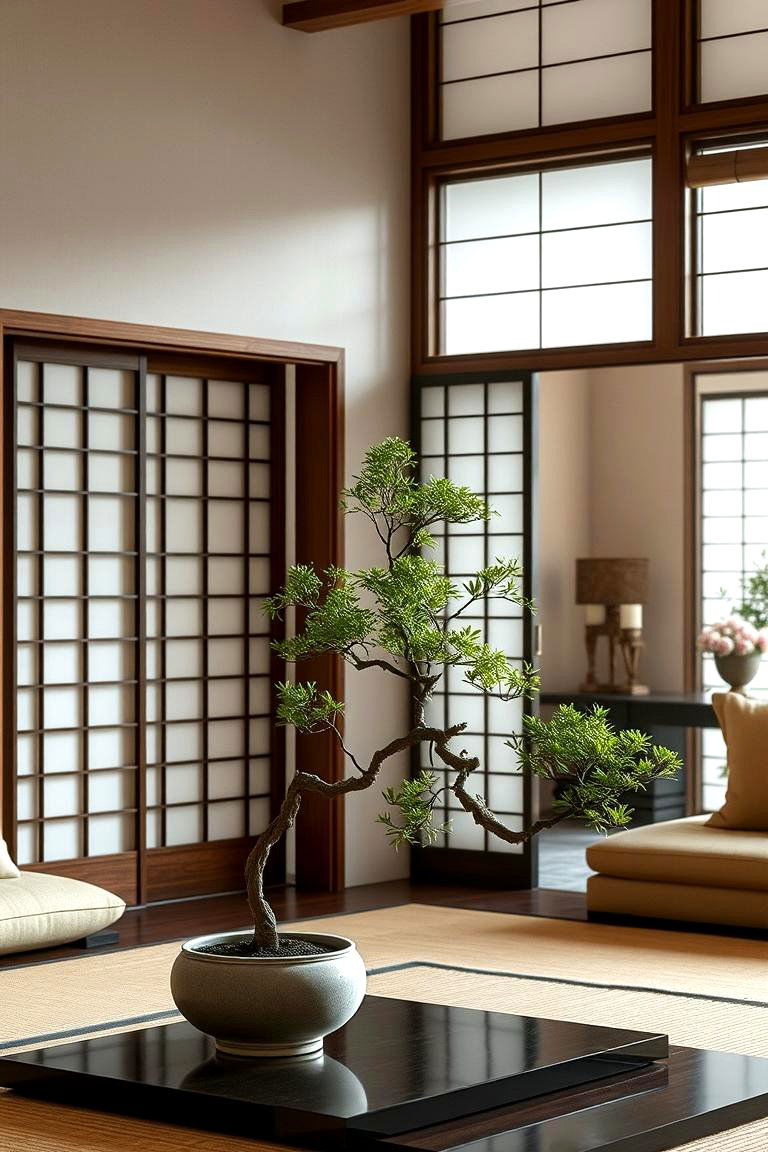
With their delicate wooden frames and translucent paper panels, shoji screens embody the essence of Japanese design. These versatile dividers are more than just functional; they are architectural elements that softly diffuse light, creating a warm and inviting ambiance. Furthermore, shoji screens offer flexibility in defining spaces, allowing you to create intimate zones within an open-plan living room or to seamlessly connect areas when desired. Their lightweight construction makes them easy to move and reconfigure, offering adaptability for various occasions and needs.
3. Low-Profile Living
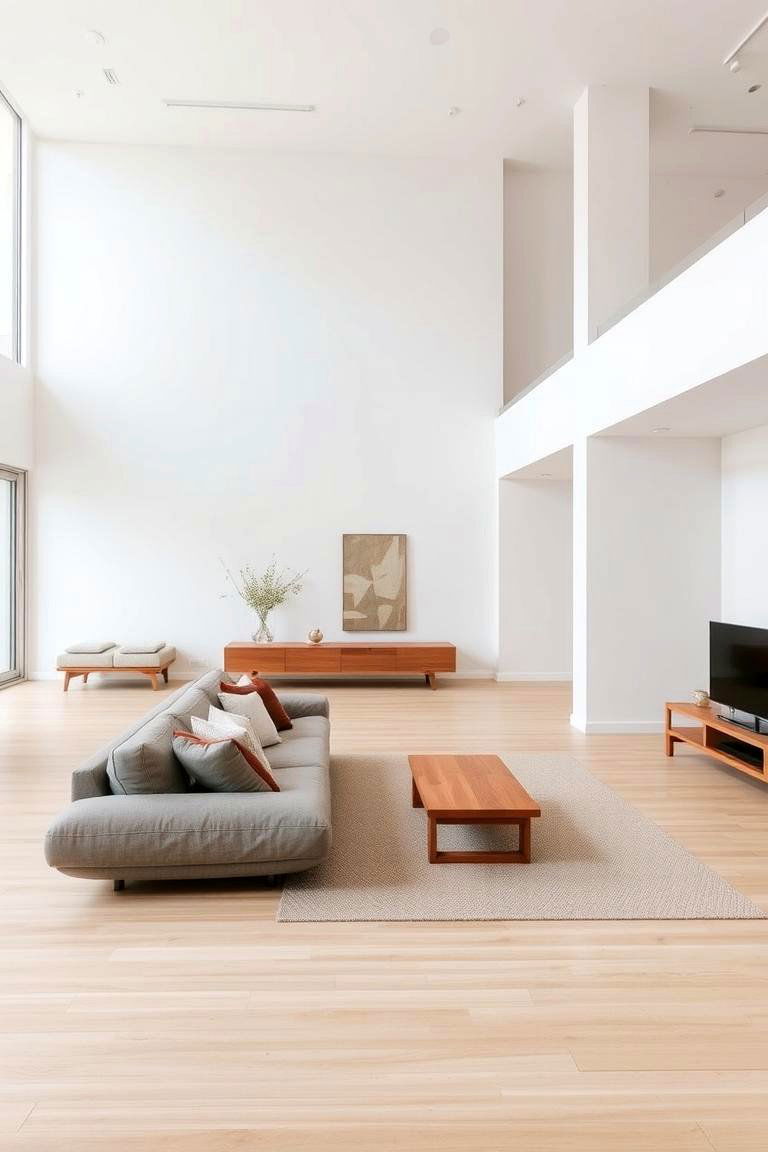
Consider a shift in perspective by embracing low-profile furniture in your Japanese-inspired living room. Unlike traditional Western layouts, Japanese design favors pieces that sit closer to the floor, fostering a sense of spaciousness and connection to the ground. This approach encourages a more relaxed and grounded atmosphere, promoting a feeling of ease and tranquility. Opt for low sofas, floor cushions, and coffee tables to create an intimate and inviting conversational area. This design choice not only enhances the aesthetic but also contributes to a more comfortable and mindful living experience.
4. Natural Wood Warmth
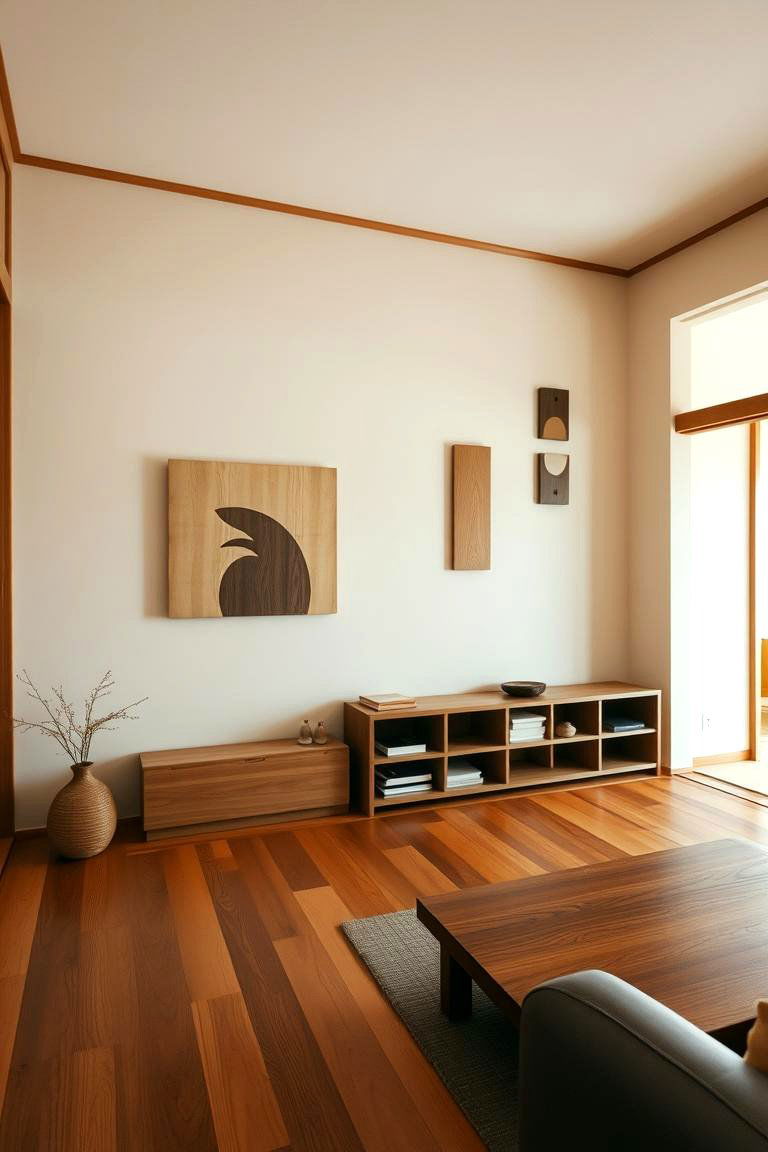
The inherent beauty of natural wood plays a pivotal role in creating an authentic Japanese living room. Bringing warmth and texture to the space, wood elements connect the interior with the outdoors, fostering a sense of natural harmony. Consider incorporating wooden flooring, wall panels, or furniture pieces with visible wood grain to enhance this connection. The subtle variations in color and texture found in natural wood add depth and character to the room, creating a visually appealing and tactilely satisfying environment. Embrace the imperfections and natural beauty of wood for a truly authentic feel.
5. Minimalist Mastery
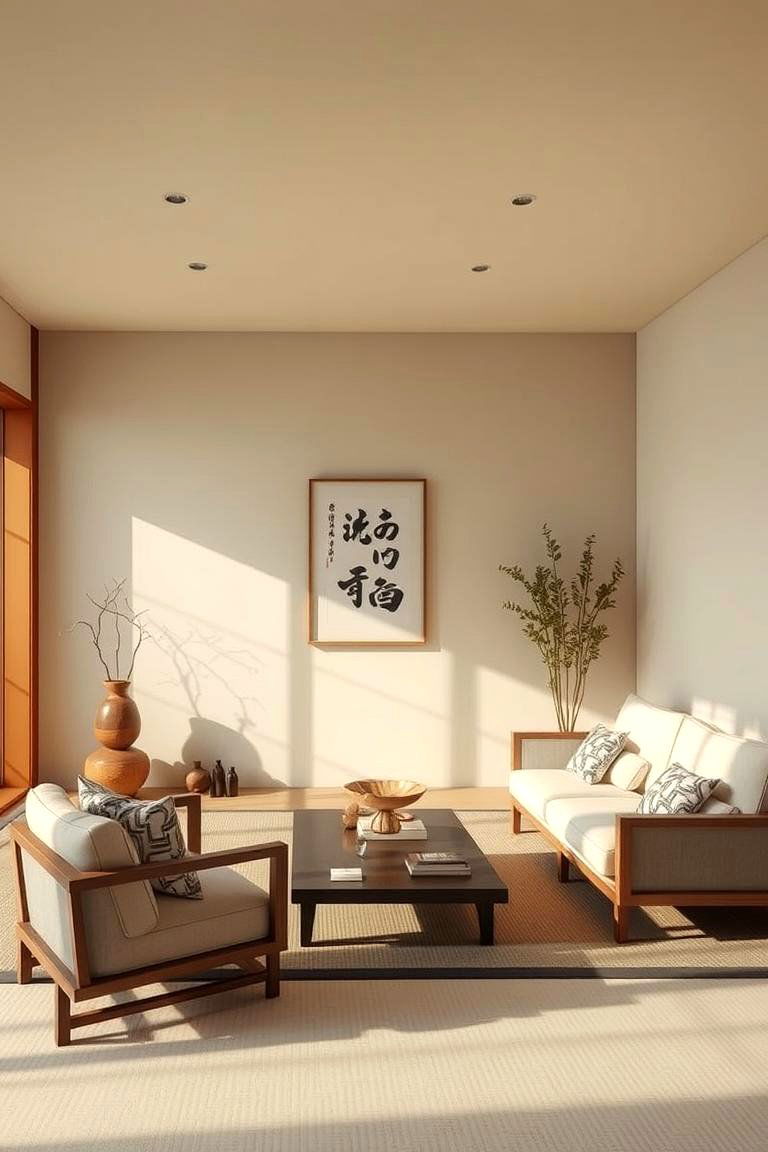
What truly defines a Japanese aesthetic is its unwavering commitment to minimalism. By decluttering and focusing on essential items, you can create a living room that exudes tranquility and order. This approach emphasizes quality over quantity, encouraging you to carefully select each piece with intention and purpose. The absence of unnecessary ornamentation allows the beauty of the remaining elements to truly shine. Embrace clean lines, simple forms, and a curated selection of decor to achieve a serene and uncluttered living space.
6. Neutral Color Calm
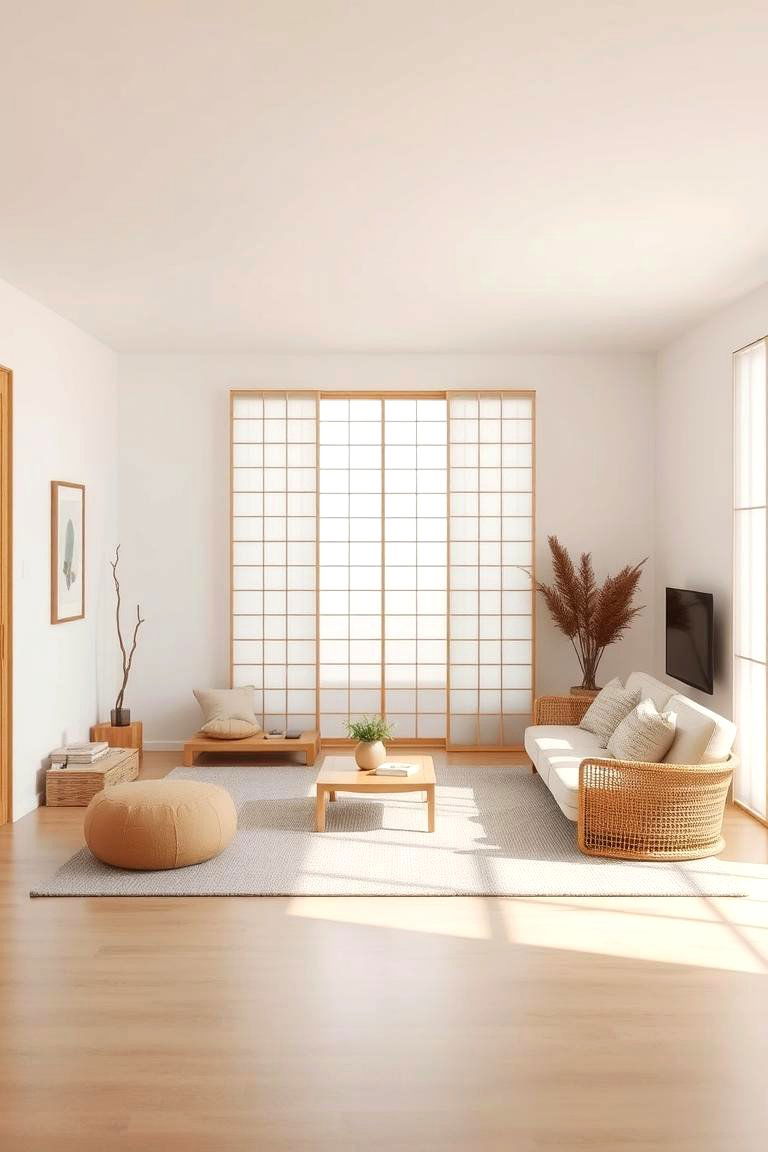
Another hallmark of Japanese design is the use of a calming neutral color palette. These serene hues, often inspired by nature, create a backdrop of tranquility and allow other elements like wood and plants to take center stage. Think soft whites, creams, grays, and earthy browns to establish a peaceful and harmonious atmosphere. These colors promote a sense of calm and visual clarity, making the living room feel more spacious and inviting. Incorporating subtle variations within this neutral range can add depth and visual interest without disrupting the overall sense of serenity.
7. Indoor Greenery Harmony
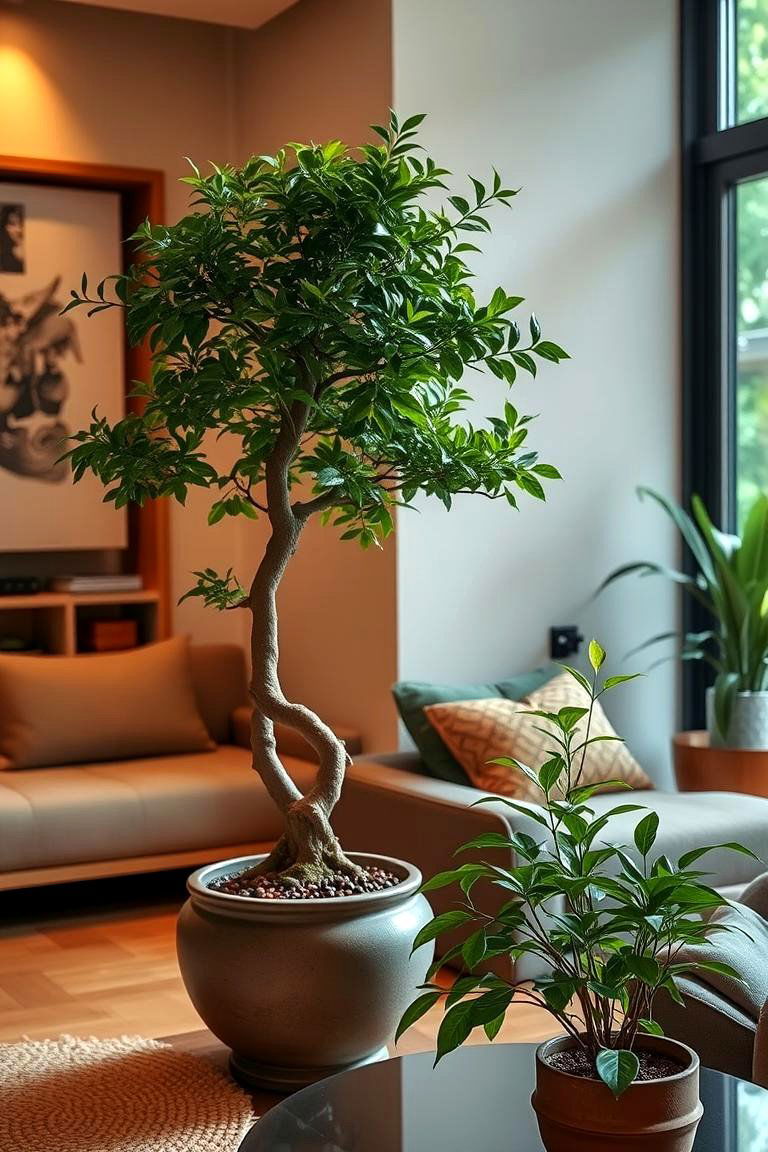
Bringing the outdoors in is fundamental to Japanese design, and indoor plants play a vital role in achieving this connection. Not only do they add a touch of natural beauty, but they also contribute to a sense of well-being and purify the air. Consider incorporating bonsai trees, with their meticulously sculpted forms, or other low-maintenance greenery to enhance the tranquility of your living room. Strategically placed plants can soften harsh lines and create a more inviting and organic feel, further blurring the boundaries between indoor and outdoor spaces.
8. Fusuma Door Flexibility
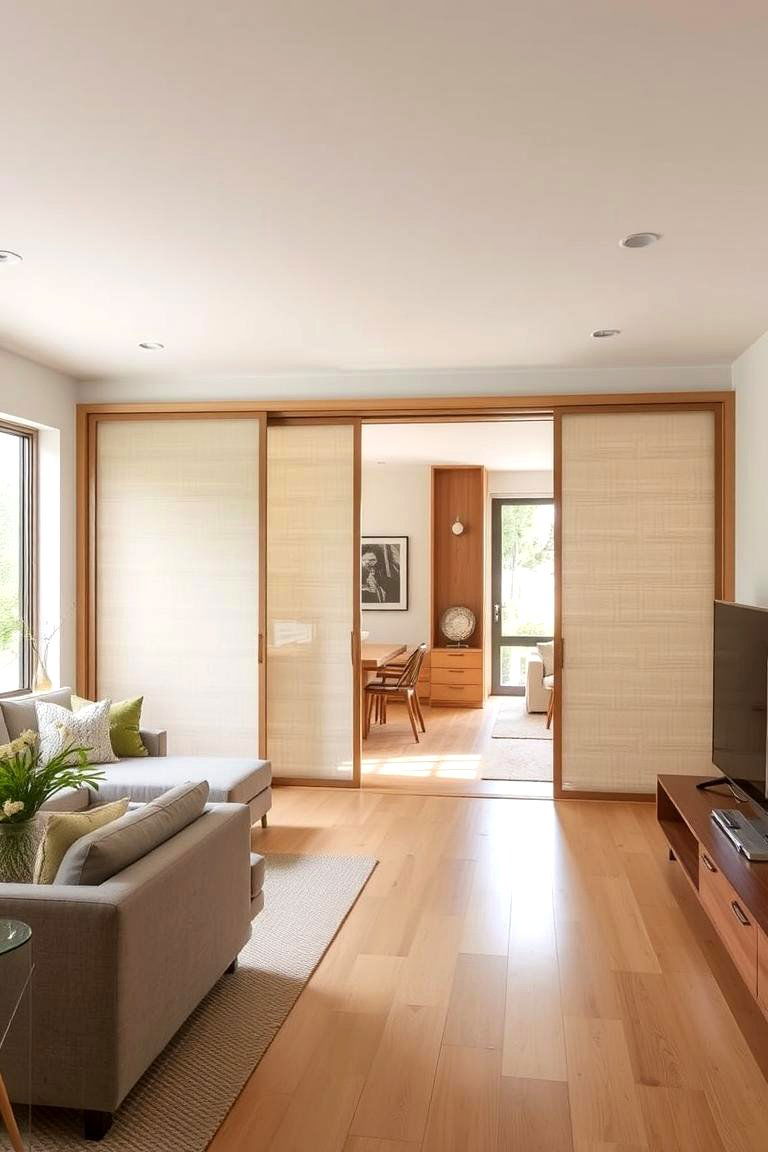
For those seeking adaptable living spaces, fusuma doors offer a practical and aesthetically pleasing solution. These sliding doors, similar in appearance to shoji screens but typically opaque, provide a greater degree of privacy and sound insulation. They allow you to easily divide a larger room into smaller, more intimate areas or to open up the space for a more expansive feel. The flexibility offered by fusuma doors makes them ideal for modern living where rooms often serve multiple purposes throughout the day.
9. Tokonoma Niche Focus
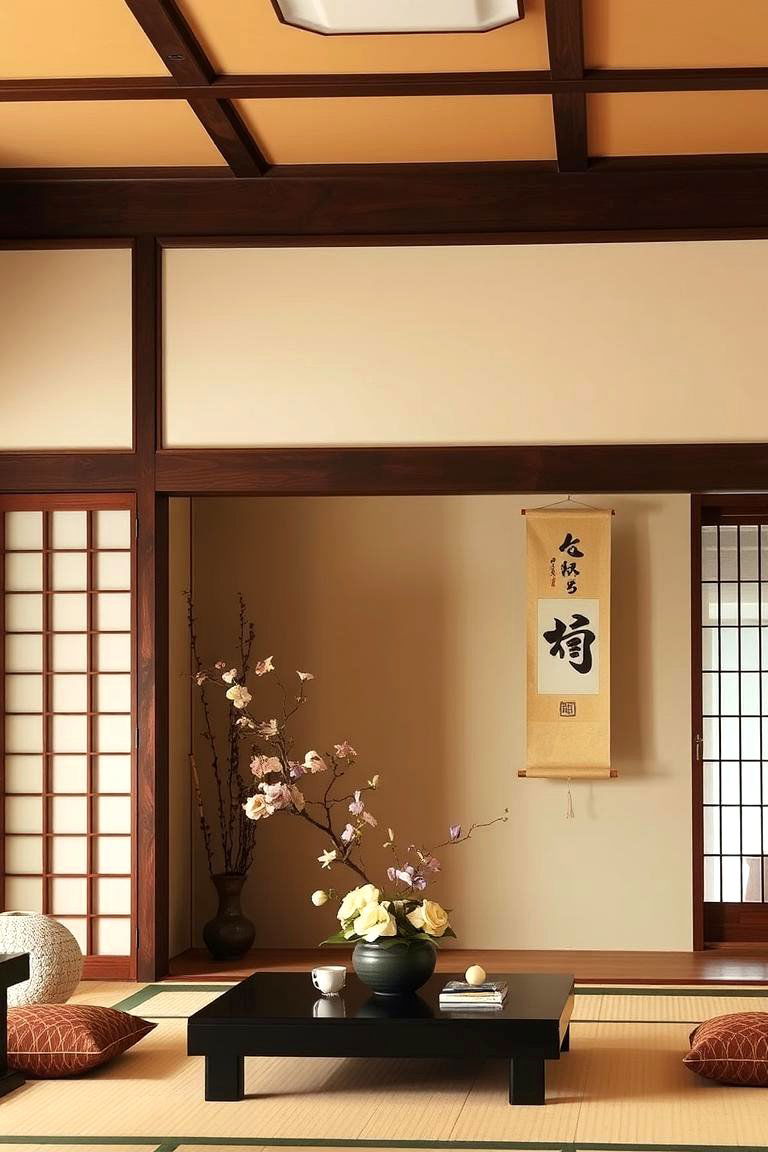
One distinctive feature of traditional Japanese living rooms is the tokonoma, an alcove designed for displaying carefully selected art, calligraphy, or seasonal decorations. This focal point adds a touch of elegance and provides an opportunity to showcase personal taste and cultural appreciation. Even in a modern interpretation, incorporating a similar niche or display area can bring a sense of intention and artistry to your living room. This dedicated space encourages mindful curation and adds a layer of visual interest and personality to the overall design.
10. Zaisu Floor Seating Comfort
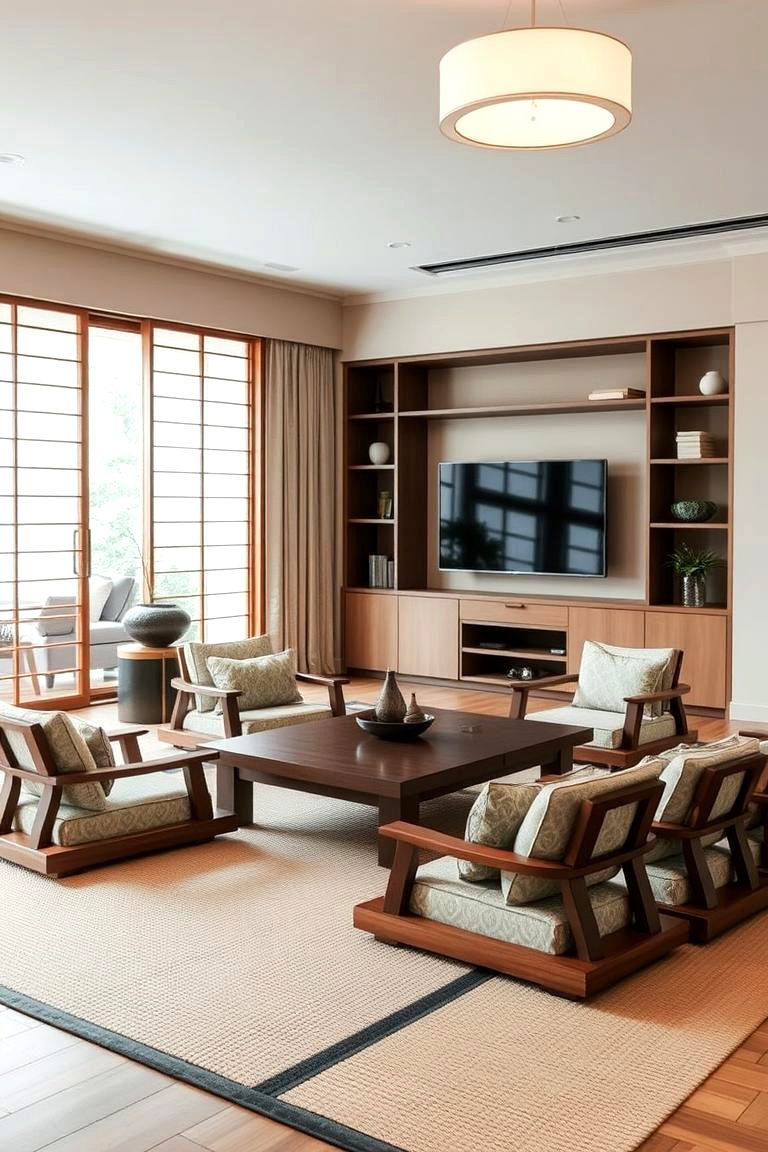
Take a seat in traditional Japanese style with zaisu floor chairs. These backless chairs provide comfortable support while maintaining a low profile, aligning with the overall design aesthetic. They encourage a more relaxed posture and a closer connection to the floor, enhancing the sense of groundedness within the space. Zaisu chairs are often used around low tables, fostering intimate gatherings and a more informal atmosphere. Their simple yet ergonomic design makes them a practical and stylish seating option for a Japanese-inspired living room.
11. Kotatsu Warmth and Gathering
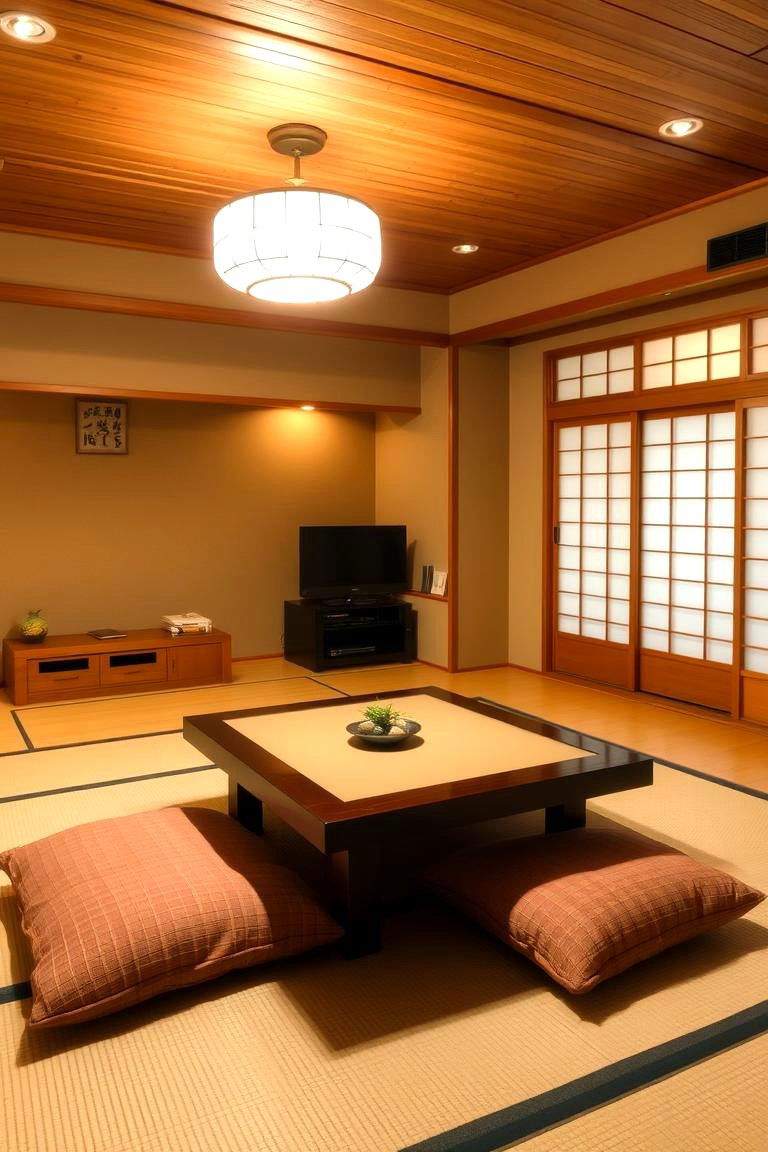
What could be more inviting during cooler months than a kotatsu? This low table features a built-in heater and is typically covered with a futon, creating a cozy and communal gathering spot. The kotatsu encourages relaxation and conversation, making it a central element in the Japanese living room during autumn and winter. It's not just a piece of furniture; it's an experience, inviting you to sit, warm your legs, and enjoy the company of loved ones. Consider a kotatsu for a unique blend of comfort and tradition.
12. Paper Lantern Soft Glow
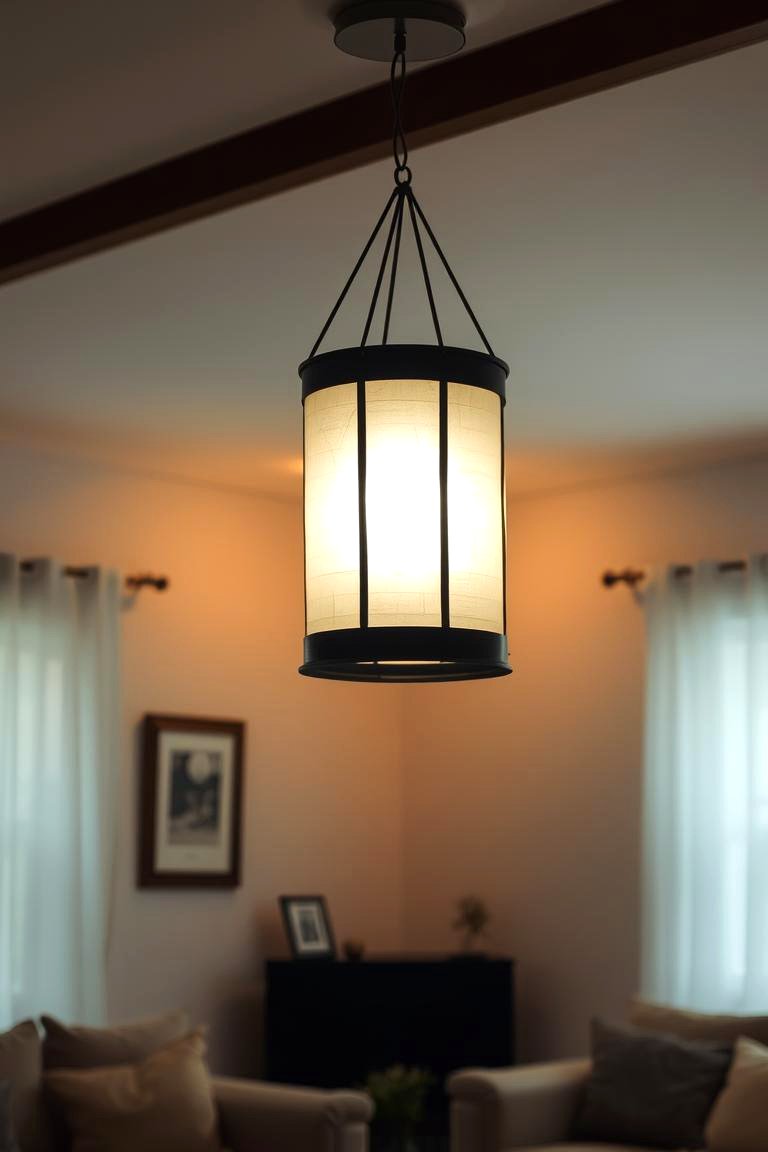
Bringing a gentle and diffused light to the room, paper lanterns are a classic element of Japanese interior design. Their soft glow creates a warm and inviting ambiance, perfect for relaxing evenings. These lightweight and often intricately designed lanterns can be hung from the ceiling or placed on tables as accent lighting. Their delicate aesthetic adds a touch of traditional charm while providing functional illumination. Choose from various shapes and sizes to find the perfect paper lanterns to complement your Japanese-inspired living room.
13. Wabi-Sabi Imperfection Embrace
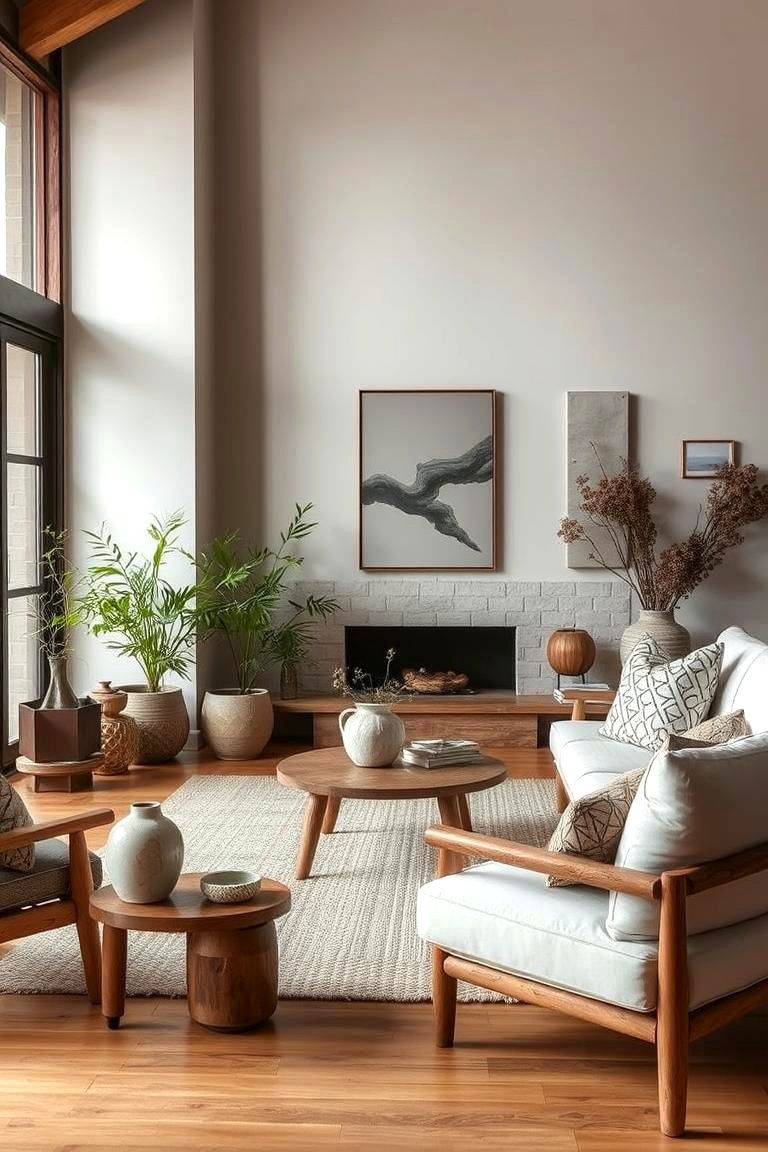
Another core principle of Japanese aesthetics is wabi-sabi, the appreciation of imperfection and transience. This philosophy encourages you to embrace the natural wear and tear of objects and to find beauty in the simple and imperfect. Instead of striving for flawless perfection, focus on the character and history of your furniture and decor. This mindset fosters a more relaxed and authentic living space, where the focus is on genuine beauty rather than manufactured perfection.
14. Stone and Rock Grounding
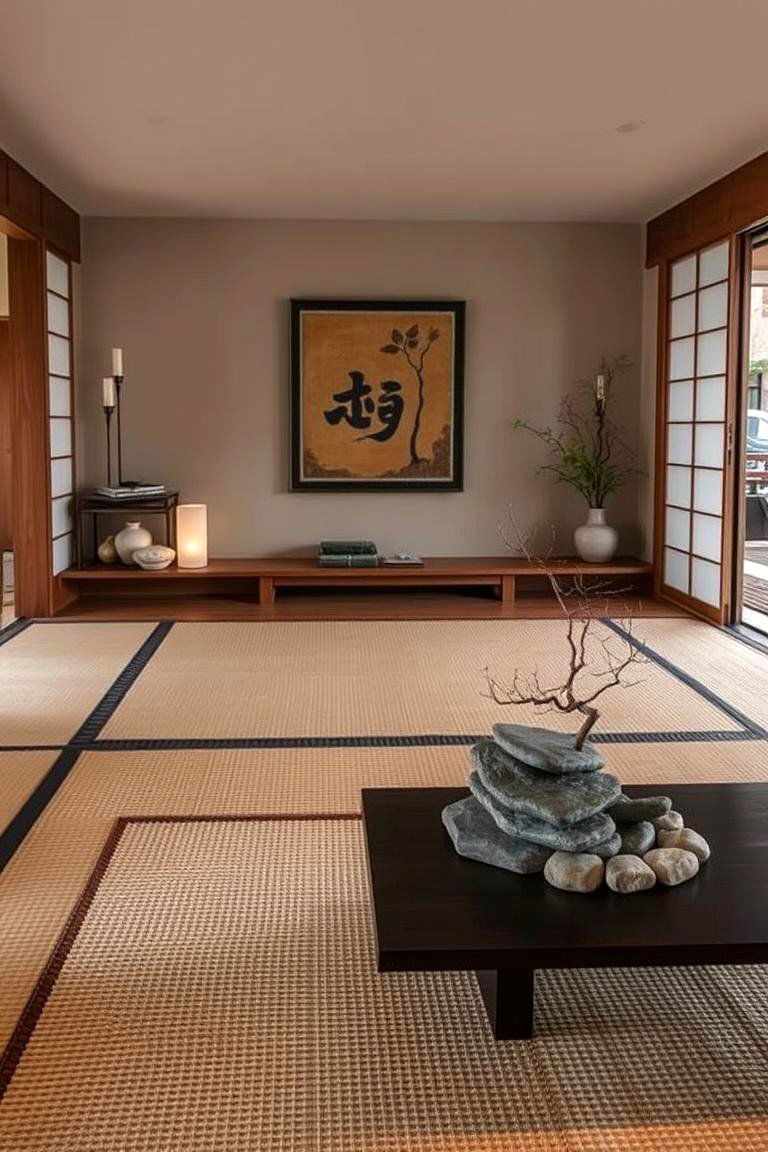
Consider incorporating natural stone or rock elements to bring a sense of grounding and connection to the earth into your Japanese living room. These materials, often used in traditional Japanese gardens, can be introduced through decorative stones, small rock gardens, or even stone-textured accents. Their presence adds a sense of permanence and tranquility to the space. The cool, smooth texture of stone provides a tactile contrast to the warmth of wood and the softness of textiles, creating a balanced and sensory-rich environment.
15. Bamboo Accent Elegance
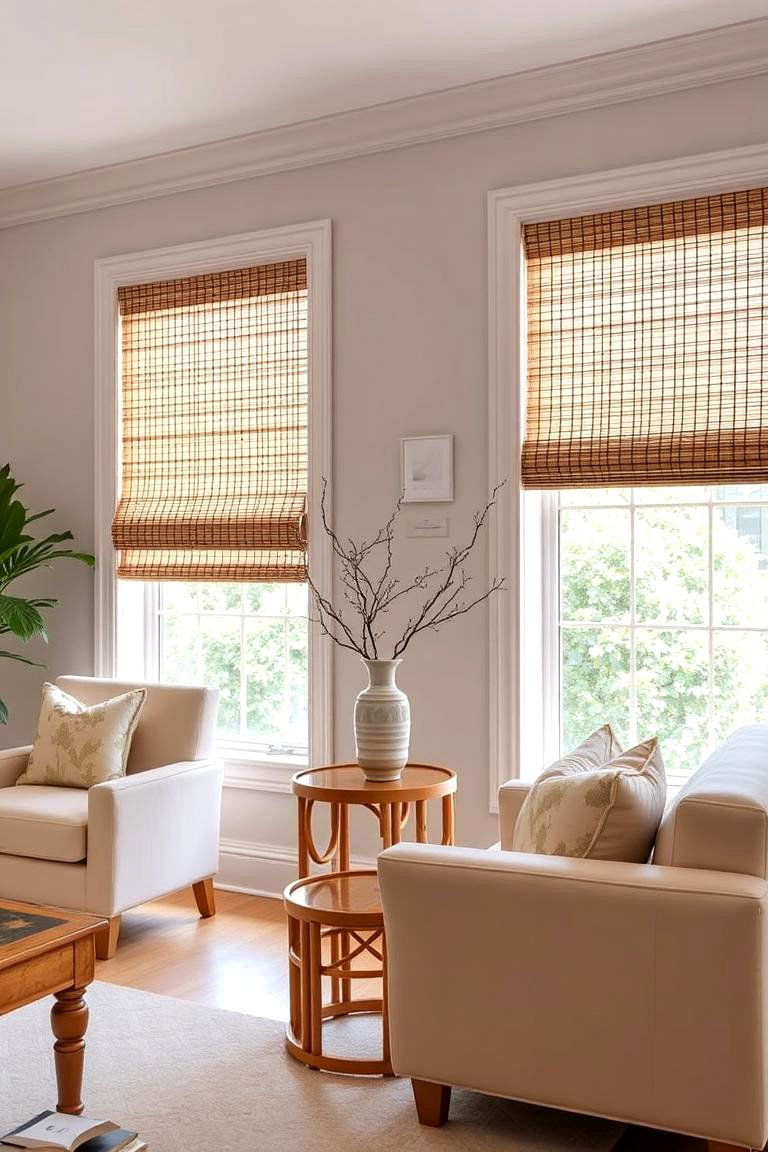
With its natural beauty and sustainable qualities, bamboo is a versatile material that adds an elegant touch to Japanese interiors. Incorporate bamboo in various forms, such as blinds, screens, decorative objects, or even furniture. Its light color and distinctive texture bring a touch of nature indoors while maintaining a sense of sophistication. Bamboo's inherent strength and flexibility make it a practical and aesthetically pleasing choice for various elements within your Japanese-inspired living room.
16. Calligraphy and Artful Display
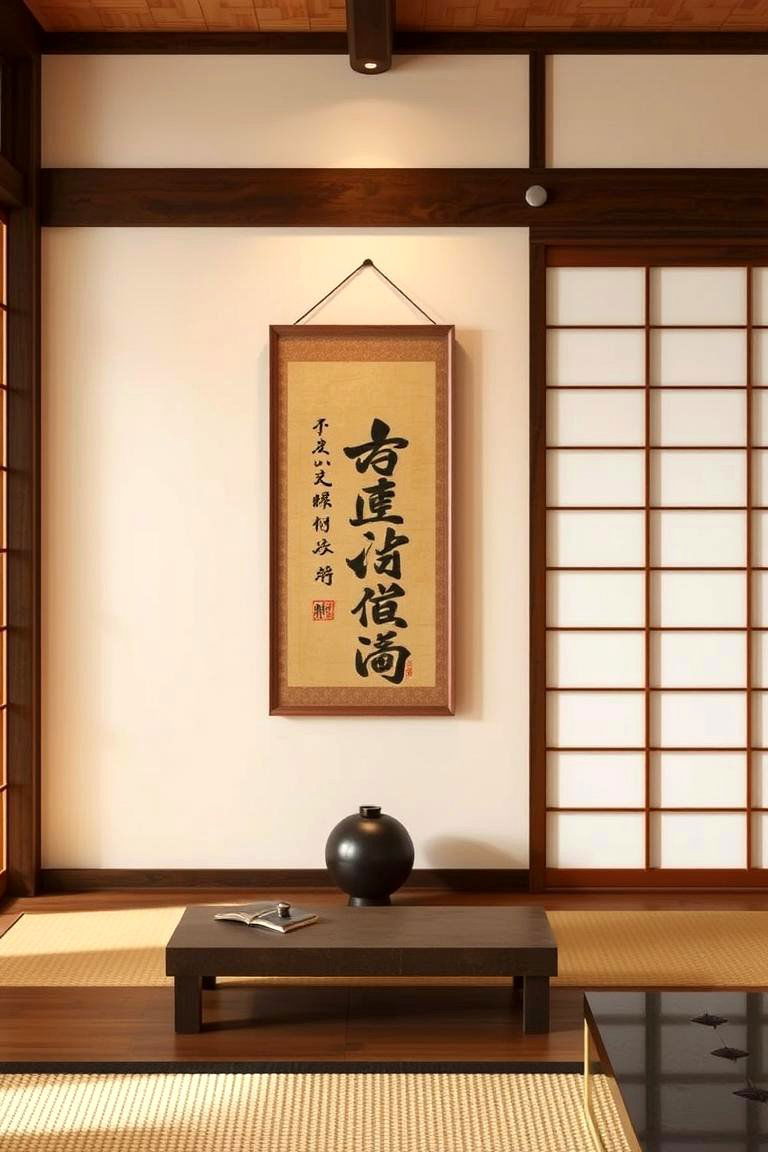
What better way to personalize your Japanese living room than with carefully chosen calligraphy or artwork? Traditional Japanese calligraphy, with its fluid brushstrokes and meaningful characters, adds a touch of cultural richness and artistic expression. Consider displaying a scroll or framed piece in your tokonoma or on a dedicated wall. Select art that resonates with the principles of Japanese aesthetics, such as nature-inspired prints or minimalist abstract pieces, to enhance the overall ambiance.
17. Open Plan Harmony
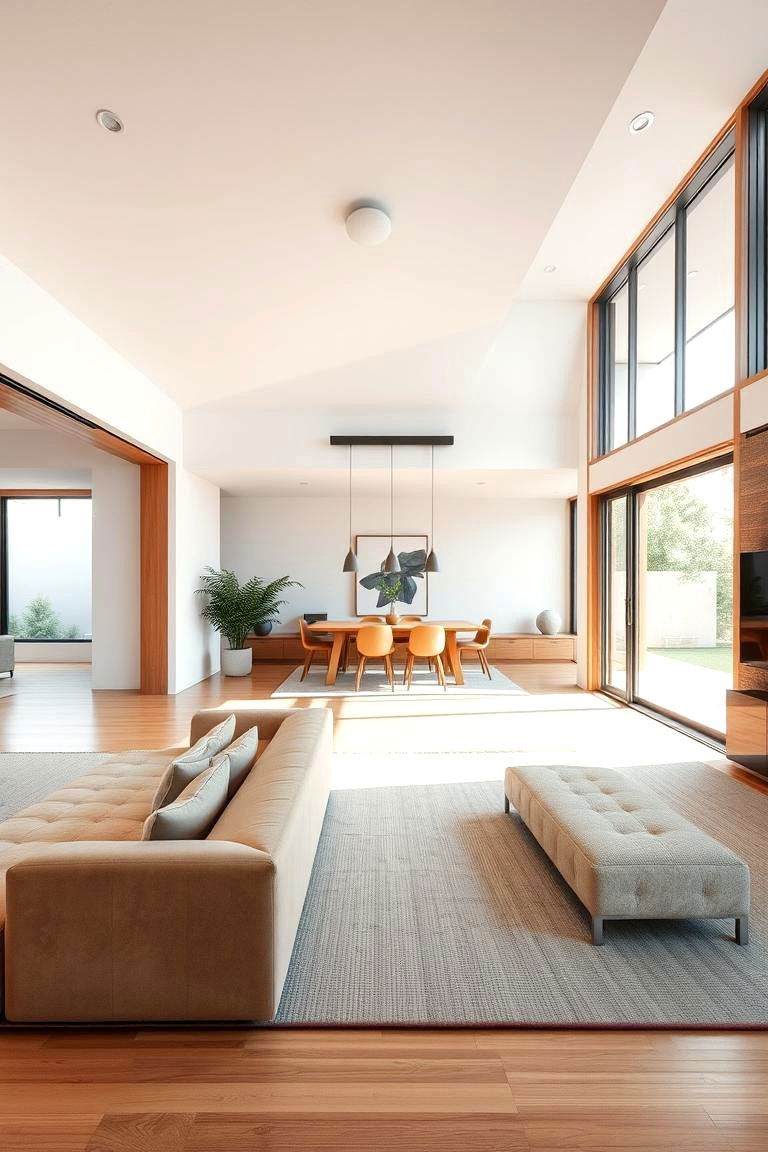
For modern homes, integrating Japanese design principles into an open floor plan can create a harmonious and flowing living space. Utilize elements like shoji screens or strategically placed furniture to subtly define different zones within the larger area without completely separating them. This approach maintains a sense of spaciousness while still providing a sense of intimacy and functionality for various activities. The key is to create a cohesive design that respects the principles of minimalism and natural flow.
18. Natural Fiber Comfort
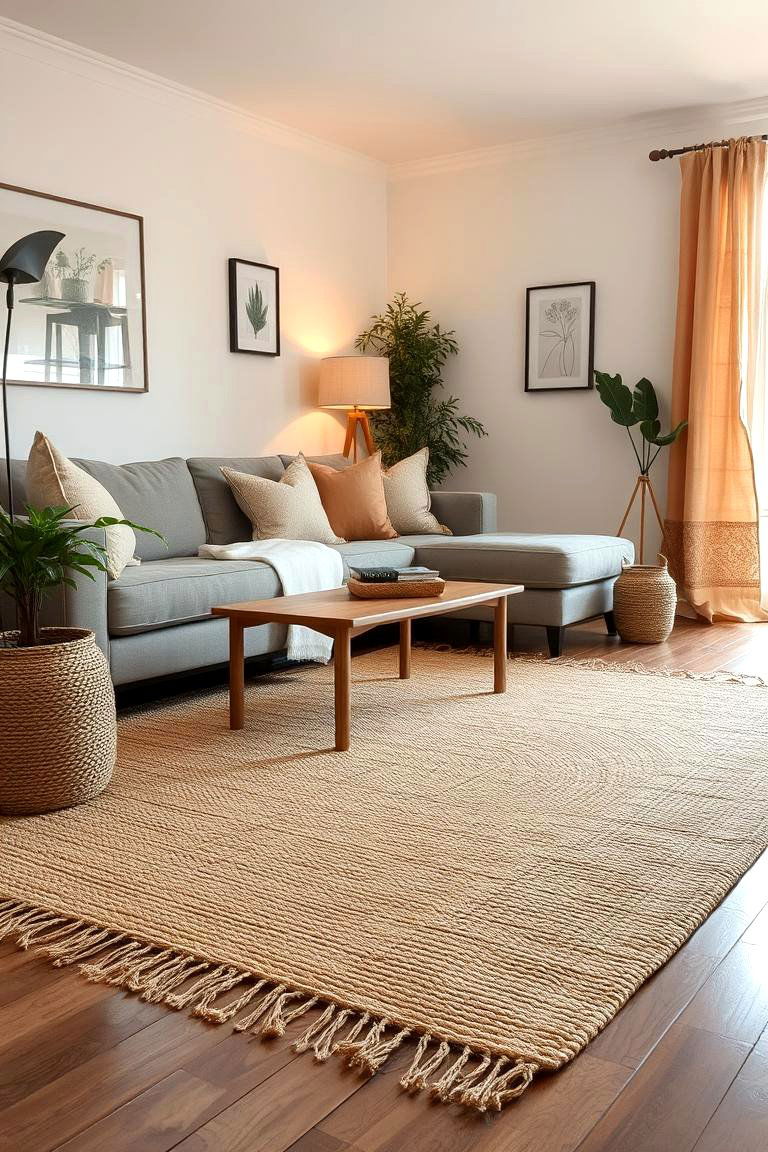
Bringing texture and warmth underfoot, natural fiber rugs are an excellent addition to a Japanese-inspired living room. Materials like jute, sisal, or seagrass offer a subtle organic feel that complements the natural wood and other elements in the space. Their neutral tones and simple textures contribute to the overall sense of calm and understated elegance. Choose a rug that defines the main living area and adds a layer of comfort without overwhelming the minimalist aesthetic.
19. Built-in Simplicity
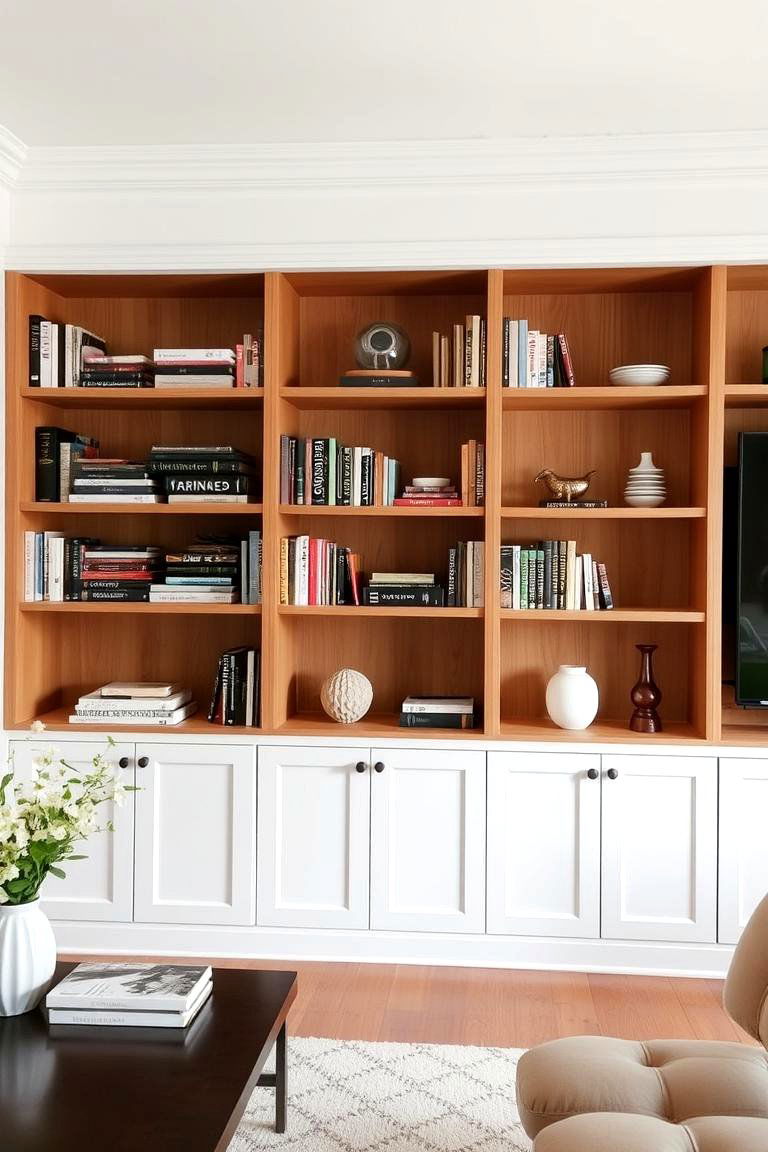
Consider incorporating built-in shelving or storage solutions to maintain a clean and uncluttered look in your Japanese living room. These integrated units provide ample space to neatly organize belongings while minimizing visual clutter. Opt for simple, clean lines and natural wood finishes to seamlessly blend with the overall design. Built-in storage not only enhances the aesthetic but also contributes to a more functional and organized living environment, promoting a sense of peace and order.
20. Natural Light Embrace
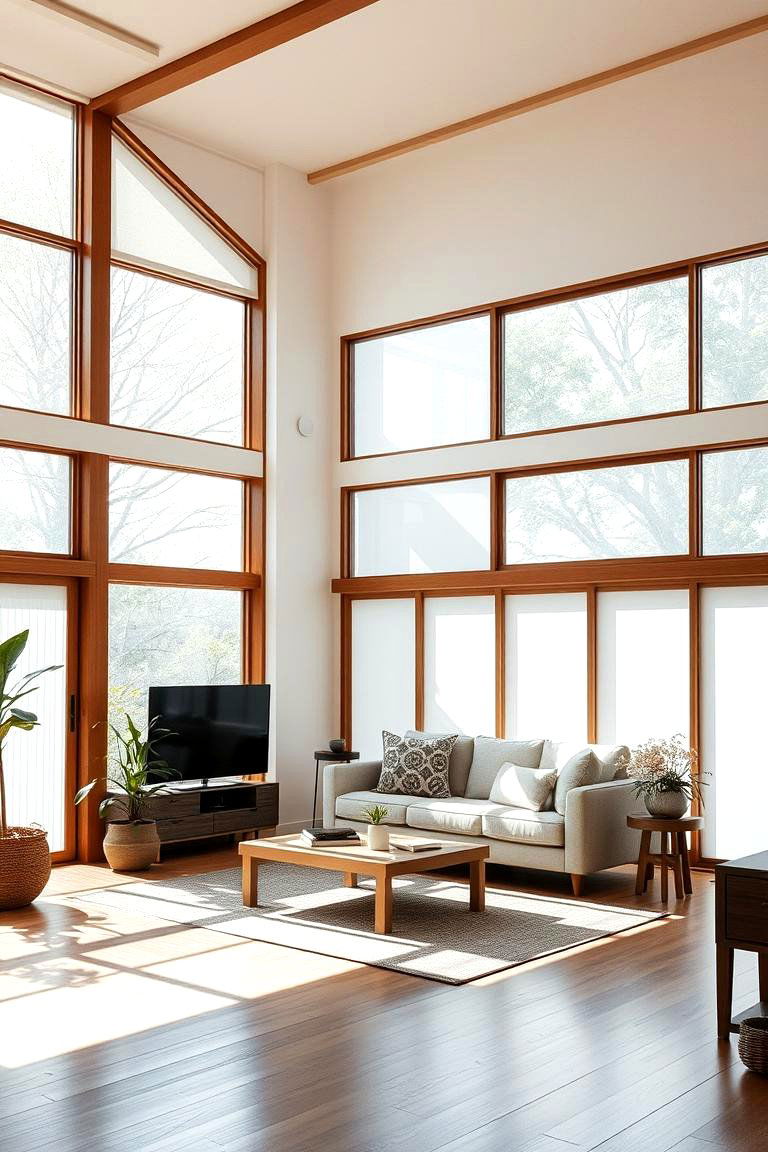
Maximizing natural light is crucial in Japanese design. Large windows or sliding glass doors help to connect the interior with the outdoors and fill the space with soft, natural illumination. Avoid heavy curtains or window treatments that block light; instead, opt for sheer blinds or shoji screens that diffuse the light gently. This emphasis on natural light enhances the sense of spaciousness and brings a vibrant yet calming energy to the living room throughout the day.
21. Tea Ceremony Corner Tranquility
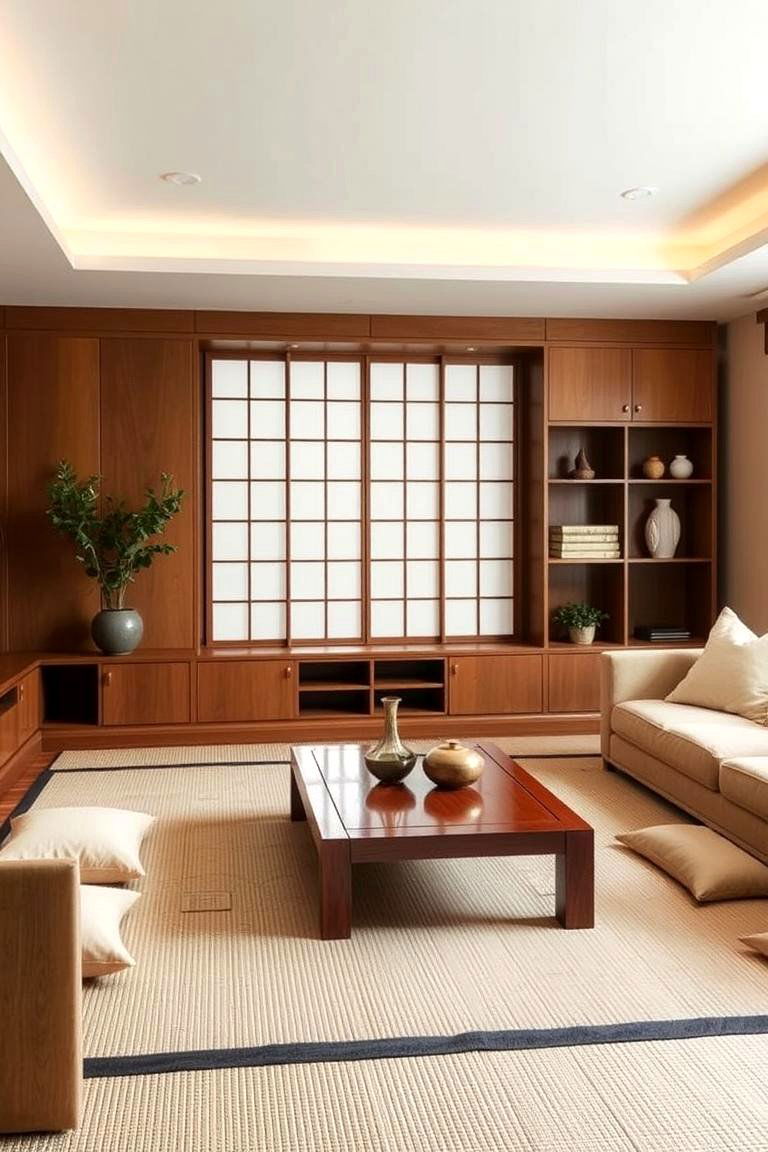
Drawing inspiration from the serene atmosphere of a traditional Japanese tea ceremony, consider creating a dedicated corner within your living room for quiet contemplation. This area could feature a low table, floor cushions, and perhaps a simple display of tea utensils or a calming piece of art. This dedicated space encourages mindfulness and provides a peaceful retreat within your home, reflecting the importance of ritual and tranquility in Japanese culture.
22. Floor Cushion Versatility
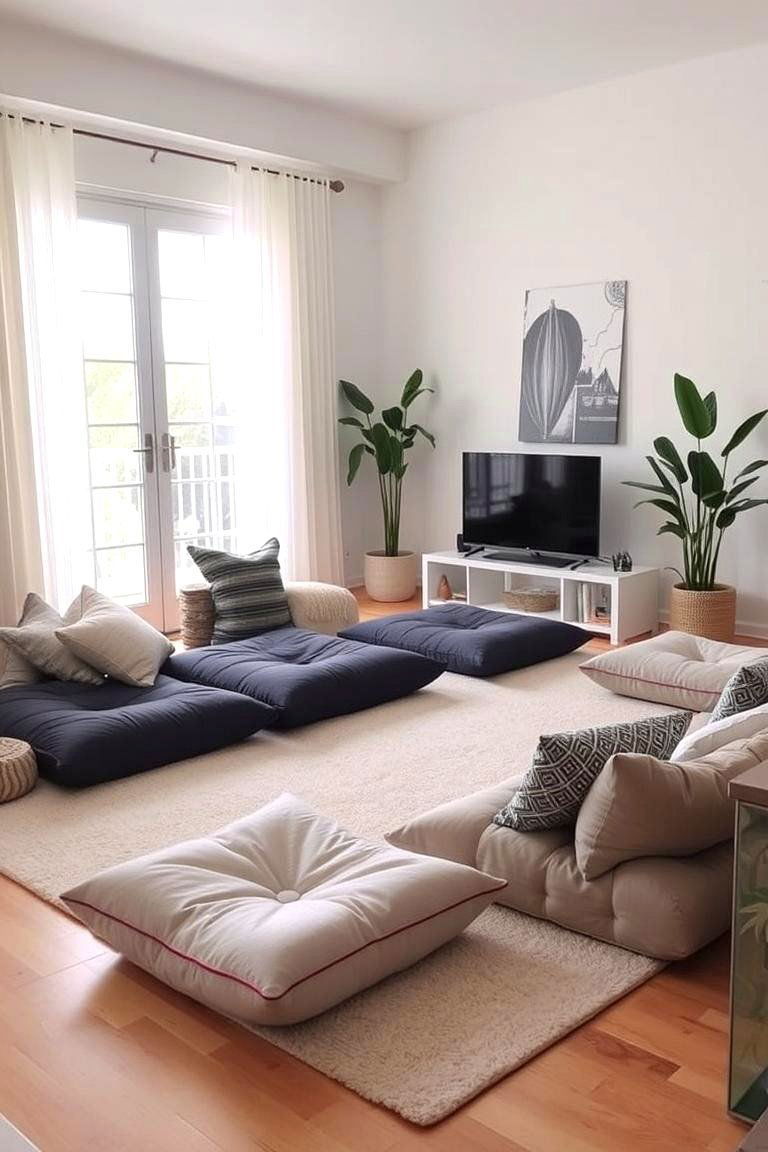
For flexible and comfortable seating options, consider incorporating floor cushions into your Japanese living room. These versatile pieces can be easily moved around to accommodate guests or to create different seating arrangements. Choose cushions made from natural materials like cotton or linen in neutral colors to complement the overall aesthetic. Floor cushions not only provide comfortable seating but also contribute to the low-profile design and the sense of spaciousness in the room.
23. Ma - The Beauty of Empty Space
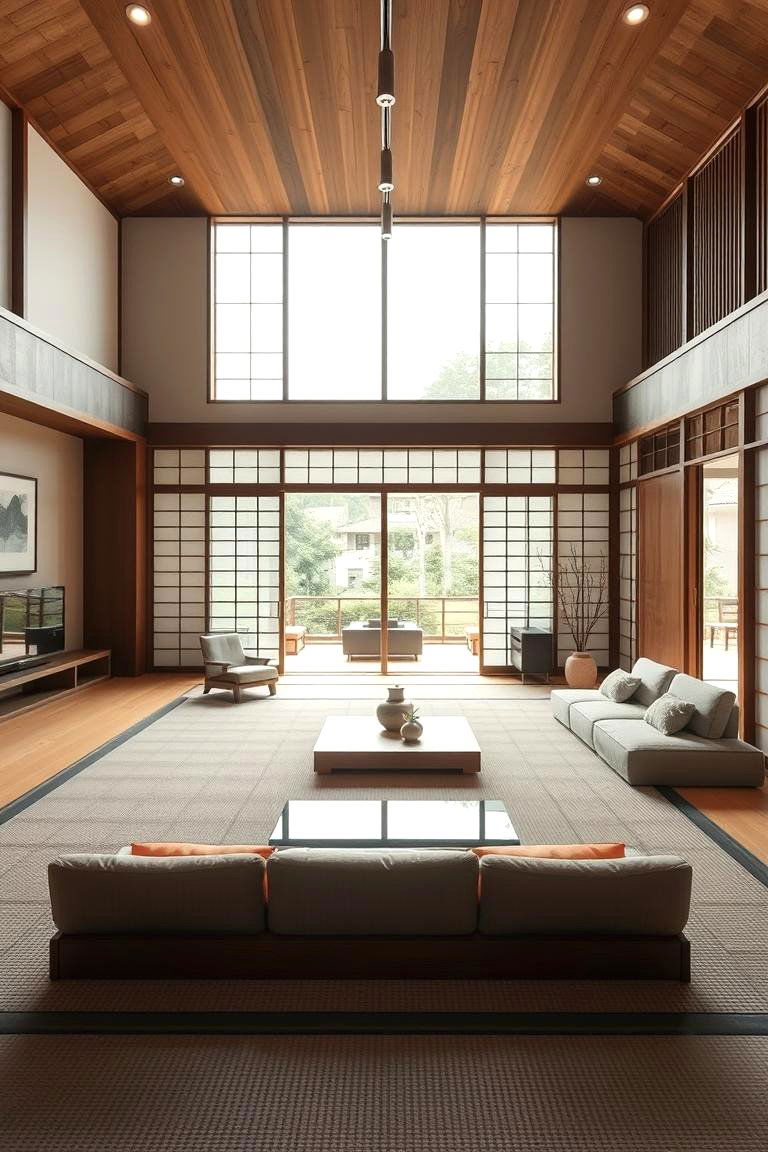
One of the most profound aspects of Japanese design is the concept of "Ma," which refers to the intentional use of empty space. Rather than filling every corner, Japanese interiors embrace negative space as an integral part of the design. This allows the existing elements to breathe and creates a sense of spaciousness and tranquility. By consciously leaving areas open, you can enhance the visual harmony of your living room and create a more calming and contemplative atmosphere.
24. Organic Material Harmony
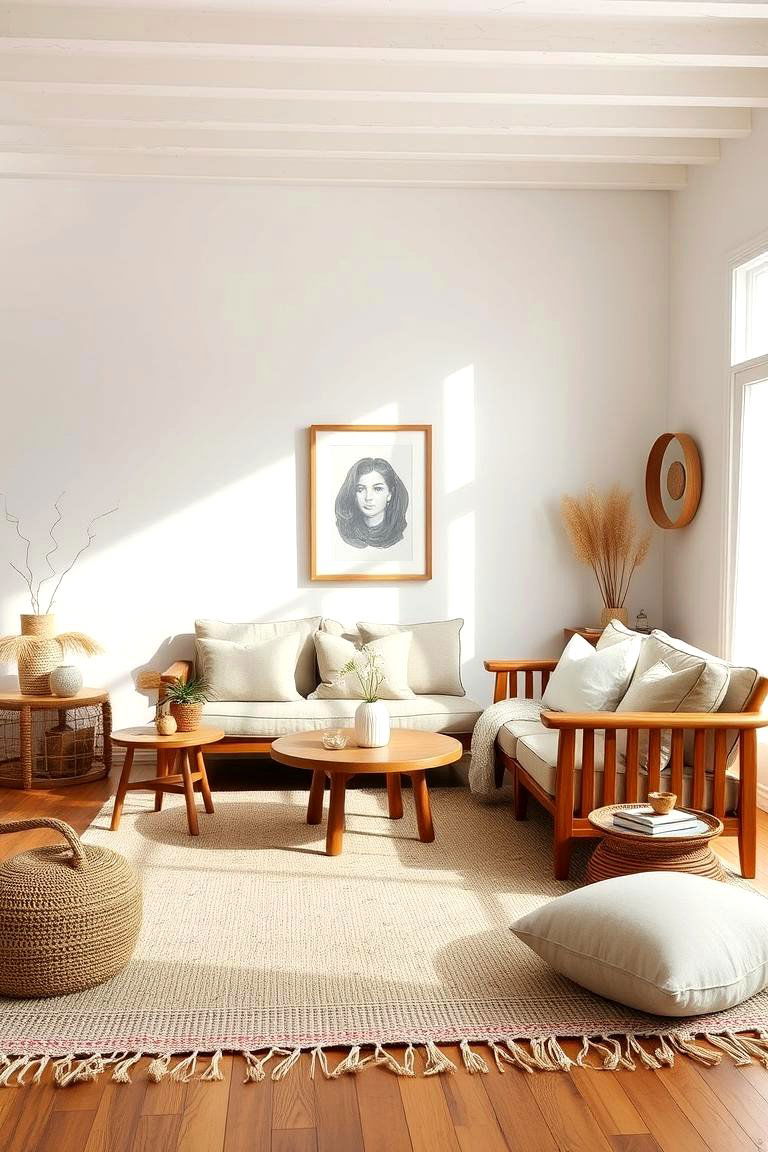
Finally, strive to incorporate organic materials throughout your Japanese-inspired living room. From natural wood and bamboo to tatami mats and paper lanterns, these materials bring a sense of warmth, texture, and connection to nature. Opt for textiles made from natural fibers like cotton, linen, and silk for upholstery and cushions. By prioritizing organic materials, you can create a living space that feels both luxurious and grounded, embodying the essence of Japanese design philosophy.
Conclusion:
Japanese style living room ideas offer a pathway to creating a serene and harmonious living space. By embracing principles of minimalism, natural materials, and a connection with the outdoors, you can transform your home into a tranquil sanctuary. From the grounding presence of tatami mats and the soft diffusion of shoji screens to the warmth of natural wood and the intentional use of empty space, each element contributes to an atmosphere of calm and understated elegance. Integrating these 24 Japanese style living room ideas allows for a personalized approach to design, ensuring a space that is both aesthetically pleasing and deeply restorative.


